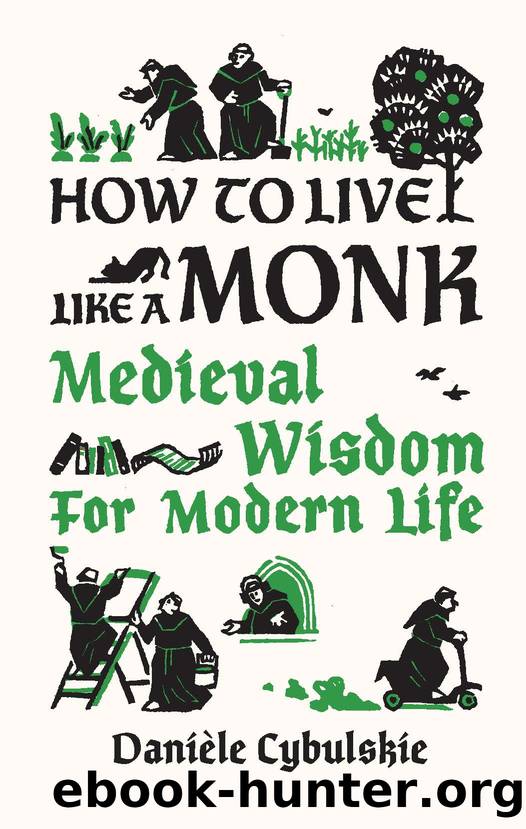How to Live Like a Monk by Danièle Cybulskie

Author:Danièle Cybulskie
Language: eng
Format: epub
Publisher: Abbeville Publishing Group
Published: 2021-10-12T20:09:59+00:00
The crucifixes to be found all over monasteries allowed for regular reflection on holy themes.
Omne Bonum (Absolucio-Circumcisio), fol. 409v, c. 1360â75 (detail)
British Library, London; Royal 6 E VI
Monastic gratitude was simple in many ways. Without God, nothing would exist at all. Without Jesus, everyone would be damned to hell for eternity. With that perspective, itâs hard not to be grateful. Human nature being what it is, however, even monks needed reminders.
One recent trend to remind modern people to be grateful for all the good in our own lives is to carry a rock in a pocket as a literal touchstone of gratitude. Every time we reach in to get keys, or coins, or just tuck our hands in, the rock is there to give us a nudge to take a moment and be grateful. In a similar way, medieval monks reminded themselves of the sacrifice of Jesus, for which they were always to be thankful, by using the sign of the cross. There were crucifixes to be found everywhere, from the church to the dormitory, and as we learned from the master of Barnwell Prioryâs instructions for the novice, every time they sat, the brothers folded their robes into the form of the cross. Barnwellâs novice was taught even more ways to be reminded of the Crucifixion throughout the day, such as,
how when he goes to bed he ought to sign himself and his bed thrice with the sign of the cross, and again when he gets up, how he should fortify himself with the same sign ⦠how he should never take food unless it have been first blessed by himself or by another and how, after food, he should give thanks to God.22
All these small moments and gestures were meant to refocus a brotherâs mind on the reason he had these blessings in the first place, so that he might be appropriately grateful, no matter how he actually felt about the early hour or day thirty-six of having Lenten eels on his plate.
Too much repetition can make symbolic gestures lose their meaning, of course, just like we might soon learn to ignore the rock in our pocket from overexposure to it. But we can also just as easily snap back into remembering why we have that habit in the first place, especially if, like medieval monks, we see it being done by other people.
Modern studies have shown that practicing gratitude in the morning or before bedtime has positive effects on peopleâs moods and on their success.23 Taking a few moments to be thankful before we start our days, or as we end them, increases happiness overall. Although nothing more than a pause for reflection is needed, experts suggest that writing down three to five things for which weâre grateful is a good idea and gives us a record of pleasant things to look back on if we find ourselves struggling on a different day. Fortunately for us, we donât need to find ourselves expensive parchment to do it:
Download
This site does not store any files on its server. We only index and link to content provided by other sites. Please contact the content providers to delete copyright contents if any and email us, we'll remove relevant links or contents immediately.
Machine Learning at Scale with H2O by Gregory Keys | David Whiting(4185)
Never by Ken Follett(3794)
Fairy Tale by Stephen King(3220)
The Man Who Died Twice by Richard Osman(2997)
Reminders of Him: A Novel by Colleen Hoover(2952)
Will by Will Smith(2794)
Rationality by Steven Pinker(2291)
Can't Hurt Me: Master Your Mind and Defy the Odds - Clean Edition by David Goggins(2228)
It Starts With Us (It Ends with Us #2) by Colleen Hoover(2199)
Friends, Lovers, and the Big Terrible Thing by Matthew Perry(2119)
The Becoming by Nora Roberts(2088)
The Stranger in the Lifeboat by Mitch Albom(2050)
Love on the Brain by Ali Hazelwood(1965)
New Morning Mercies: A Daily Gospel Devotional by Paul David Tripp(1877)
HBR's 10 Must Reads 2022 by Harvard Business Review(1777)
The Strength In Our Scars by Bianca Sparacino(1776)
A Short History of War by Jeremy Black(1762)
Never Finished: Unshackle Your Mind and Win the War Within by David Goggins(1641)
515945210 by Unknown(1599)
